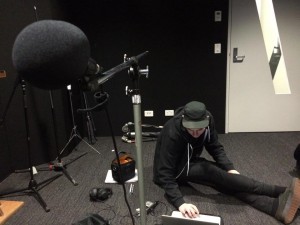25-05-15
Entering the Design Hub armed with my fellow soldier Gloria and our weapons of choice (Microphone, XLR cord, Portable Recorder and Notepads), I found myself nervous and strangely excited at the idea of interviewing Dr. Lawrence Harvey in his battleground (the SIAL Studios).
SIAL = Spatial Information Architecture Laboratory. It is a partially independent branch of RMIT that focuses its efforts on discovering the potential that spatial sound and design has on the audio, architectural, scientific and theoretical frontiers of the modern world.
Being guided down the halls of this grandiose building is an experience that can only be likened to that of walking through the Starship Enterprise. Huge concrete walls engulf your vision and dwindle and natural light that penetrates through the front door.. the walls are only interrupted by discrete corners housing futuristic designs of model buildings and ginormous doors that took the Zealander approach and were at least “3 times bigger” than the average rectangular holes in walls we are used to.
After navigating the near endless maze of corridors to get to the SIAL Studios, we finally arrived and were welcomed by a plethora of audio and sound gear that would make any audiophiles appendage stand to attention.
Being prompted by Lawrence to “pull up a seat and make {ourselves} comfortable”, both Gloria and myself unraveled our weapons and began the arduous process of setting up for the interview. After we managed to untangle the cords and route the signals, we unpacked our notebooks tentatively delivered our first blow.
Once the formalities were aside and the awkwardness of addressing a Dr. had subsided, the interview began to unfold before our very ears and conversation flowed quite naturally. Exchanging witty repartee, in-depth conversations about audio technology and the choice of Lawrence’s yoghurt (vaalia in case you were wondering), the three of us engaged in a discussion that went uninterrupted until we noticed that our time was almost up.
It was at this moment that Lawrence offered for gloria and myself to witness the gear in its full glory, as he decided to play a spatially mixed piece of audio that would engulf us in its beauty.
To say I was excited at this notion would be an understatement.
3, 2, 1….
Whooooah!!
It was an experience! A thing of sheer awesomeness!! It managed to immerse us all in its frequencies and travel around the room at will, formulating a mix of epic proportions.
The clock struck 2:00 and these little mice had to leave as Lawrence had a class to facilitate.
I urge anyone out there reading this blog to go in and see the SIAL Studios and experience the awesomeness that is Spatial Sound, for it will not be the last time that one will find me there.
– donandsherri
